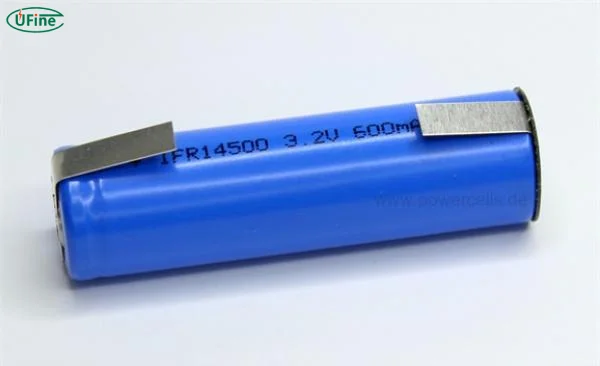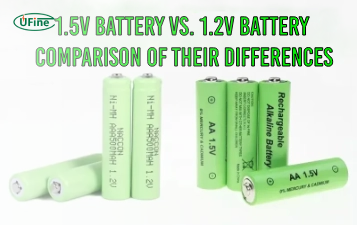
- Part 1. Understanding 3.2V AA battery
- Part 2. Size and weight
- Part 3. Chemistry
- Part 4. Capacity
- Part 5. Applications
- Part 6. 3.2V LiFePO4 battery vs 3.2V AA battery
- Part 7. 3.2V AA battery and a 14500 AA battery
- Part 8. What is the difference between 3.2V AA battery and other AA batteries?
- Part 9. 3.2V AA battery charging tips
- Part 10. Conclusion
When it comes to battery-powered devices, most of us are familiar with the classic AA battery. However, in recent years, there’s been a rise in interest for specific types of AA batteries, such as the 3.2V AA battery. You might be wondering, “What makes this 3.2V battery so special?” Well, you’re in the right place. In this article, we’re going to explore everything you need to know about the 3.2V AA battery, from its characteristics to how it compares with other types. So, whether you’re a tech enthusiast or just looking for the right battery for your device, this guide will help you make an informed choice.
Part 1. Understanding 3.2V AA battery

First things first, let’s get a good grasp of what exactly a 3.2V AA battery is. Traditionally, AA batteries are known for their 1.5V output. However, the 3.2V AA battery is a bit different. It’s not just about the voltage; it’s about how that voltage is sustained and what kind of devices it’s meant to power.
A 3.2V AA battery is typically a type of rechargeable battery, often made using lithium iron phosphate (LiFePO4) chemistry, which we’ll dive into later. These batteries offer a higher voltage output than typical AA batteries, which can make them suitable for more demanding devices.
But, unlike standard alkaline AA batteries, the 3.2V AA battery is designed for long-term use. It can provide consistent power, even under heavy loads, making it ideal for applications that require more than just a quick burst of energy.
All About AA Rechargeable Batteries
Part 2. Size and weight
When it comes to size, the 3.2V AA battery follows the standard AA dimensions. It’s about 50.5 mm in length and 14.5 mm in diameter, just like any other AA battery. So, physically, it can fit into most devices that require AA batteries, which makes it super convenient.
However, it’s important to note that the weight of the 3.2V AA battery may vary depending on its chemical composition. Generally, lithium-based batteries tend to be lighter than their alkaline counterparts, so a 3.2V AA battery might feel a little lighter while still delivering more power. This lighter weight doesn’t compromise its capacity—rather, it makes it more portable and convenient for various uses.
Part 3. Chemistry
The chemistry of a 3.2V AA battery is one of the things that sets it apart. Unlike the standard AA batteries that use alkaline chemistry, 3.2V AA batteries often utilize Lithium Iron Phosphate (LiFePO4) chemistry. This is where the magic happens.
LiFePO4 batteries have a higher charge capacity and longer lifespan than their alkaline counterparts. They are also known for being incredibly stable, which means they are less prone to overheating or leakage. This chemistry allows for a higher voltage (3.2V) and provides a much longer cycle life—up to 2,000 charge/discharge cycles in some cases. That means fewer replacements and more reliable performance over time.
Additionally, LiFePO4 batteries are considered environmentally friendly, as they are free of toxic heavy metals like cobalt, which is often found in other lithium-based batteries.
Part 4. Capacity
When we talk about battery capacity, we’re referring to how much energy the battery can store and how long it can power a device before needing a recharge. The capacity of a 3.2V AA battery usually ranges from 600mAh to 1,000mAh, depending on the manufacturer and the specific battery model.
For reference, this is much higher than the capacity of standard alkaline AA batteries, which typically have a capacity of around 2,500mAh but at a much lower voltage (1.5V). The higher voltage of the 3.2V AA battery allows it to deliver more consistent power throughout its discharge cycle, even as it starts to run low.
Part 5. Applications
So, what can you actually use a 3.2V AA battery for? Because of its higher voltage, this battery is well-suited for devices that require sustained power over a longer period. Common applications include:
- Remote control devices: Many modern remote controls, especially those with advanced features, require more power.
- Toys and gadgets: Certain electronic toys or gadgets that demand a steady current can benefit from the power of a 3.2V AA battery.
- Solar-powered devices: Some 3.2V AA batteries are used in solar-powered systems, especially for low-power applications like garden lights or outdoor sensors.
Part 6. 3.2V LiFePO4 battery vs 3.2V AA battery
It’s important to clarify that 3.2V AA battery and 3.2V LiFePO4 battery are terms that are sometimes used interchangeably, but they can refer to different things. In most cases, when people refer to a 3.2V AA battery, they are talking about a LiFePO4 battery designed to fit into the same size form factor as an AA battery.
The difference lies in the chemistry and design. A 3.2V LiFePO4 battery will typically last longer, have a higher cycle life, and be more stable in varying temperatures compared to other types of lithium-based AA batteries, like lithium-ion or standard alkaline.
Part 7. 3.2V AA battery and a 14500 AA battery
While both 3.2V AA and 14500 AA batteries offer higher performance than traditional alkaline AA batteries, they have distinct characteristics that make them suitable for different applications. Here’s a detailed comparison of the two:
1. Voltage
- 3.2V AA: Offers a consistent 3.2 volts throughout its discharge cycle.
- 14500 AA: Provides a higher nominal voltage of 3.6-3.7 volts.
2. Chemistry
- 3.2V AA: Uses Lithium Iron Phosphate (LFP) chemistry, known for its safety and stability.
- 14500 AA: Employs Lithium-ion chemistry, which offers high energy density but can be less stable under certain conditions.
3. Energy Density
- 3.2V AA: Offers higher energy density than alkaline batteries but lower than 14500 AA batteries.
- 14500 AA: Provides the highest energy density among the two, making it ideal for devices requiring longer runtime.
4. Cycle Life
- 3.2V AA: Generally has a longer cycle life, meaning it can withstand more charge-discharge cycles before significant capacity loss.
- 14500 AA: Offers a good cycle life, but it may degrade faster than LFP batteries, especially if subjected to high temperatures or rapid charging.
5. Safety
- 3.2V AA: Considered safer due to its stable LFP chemistry, which is less prone to thermal runaway.
- 14500 AA: Can be less stable, especially if mishandled or subjected to extreme conditions. Proper charging and storage are crucial.
6. Charging
- Both: Require specific chargers designed for their respective chemistries.
- 3.2V AA: May have slower charging times compared to 14500 AA.
- 14500 AA: Can be charged relatively quickly, especially with advanced chargers.
7. Cost
- 3.2V AA: Typically more expensive than traditional alkaline batteries but can be more cost-effective in the long run due to their longer lifespan.
- 14500 AA: Generally more affordable than 3.2V AA batteries but may require replacement more frequently.
Part 8. What is the difference between 3.2V AA battery and other AA batteries?
Let’s talk about how the 3.2V AA battery stands up to other common AA batteries.
- Voltage: As mentioned, the standard AA battery is usually 1.5V, while the 3.2V AA battery operates at a much higher voltage. This means the 3.2V battery is ideal for devices that require a more powerful and consistent output.
- Chemistry: While traditional AA batteries use alkaline chemistry, the 3.2V AA battery is most commonly based on LiFePO4 chemistry. This chemistry gives the 3.2V AA battery a much longer life cycle and makes it safer to use.
- Rechargeability: Unlike many AA batteries that are single-use (like alkalines), the 3.2V AA battery is often rechargeable. This means it can be used many times over, saving you money in the long run.
Part 9. 3.2V AA battery charging tips
If you’re using a rechargeable 3.2V AA battery, you might be wondering how to charge it properly. Here are a few tips:
- Use the right charger: Always use a charger designed for LiFePO4 batteries. Regular chargers might not deliver the correct voltage and can damage the battery.
- Avoid overcharging: Overcharging can decrease the lifespan of the battery. Most modern chargers have automatic shutoff features to prevent overcharging, but it’s still worth monitoring the charging process.
- Charge at room temperature: Extreme temperatures can negatively affect the charging process. It’s best to charge your 3.2V AA battery in a cool, dry place.
Charging Chart: Here’s a quick overview of typical charging times for a 3.2V AA battery:
| Capacity (mAh) | Charging Time (hrs) |
|---|---|
| 600 | 2-3 hours |
| 1000 | 3-4 hours |
Part 10. Conclusion
Choosing the right battery is crucial, and understanding the unique features of the 3.2V AA battery can help you make an informed decision. Whether you’re replacing a battery in your device or looking for one with better longevity and performance, the 3.2V AA battery could be a great fit. Just make sure to follow the correct charging and handling procedures to get the most out of your battery.
If you’re in the market for a reliable, rechargeable battery that offers consistent power, then the 3.2V AA battery might just be what you need!
Related Tags:
More Articles

1.5V Battery Vs. 1.2V Battery: Comparison of Their Differences
Compare 1.2V vs 1.5V batteries: voltage, usage, rechargeability. Best for remotes, toys, cameras. Discover which AA battery suits your device.
Recommended 10 Best Batteries For Smoke Detectors
Discover the best batteries for smoke detectors in 2025. Compare top 10 9V and AA options for long-lasting, leak-proof, and reliable smoke alarm power.
Triple A Battery Voltage: Everything You Need to Know
Learn how many volts are in a triple A battery (1.5V vs 1.2V), see AAA battery voltage chart, and compare chemistry, testing, and lifespan for 2025 devices.
9V vs AA Batteries for Fire Alarm: Which One Should You Use?
Compare 9V and AA batteries for smoke detectors. Learn which type provides better lifespan, voltage, and cost efficiency to keep your fire alarms reliable.
Flashlight Battery Size: Types, Choosing Tips and FAQs
Explore flashlight battery sizes with an easy chart. Learn what batteries small flashlights use and how to pick 18650, 26650, 14500, or CR123A cells.


